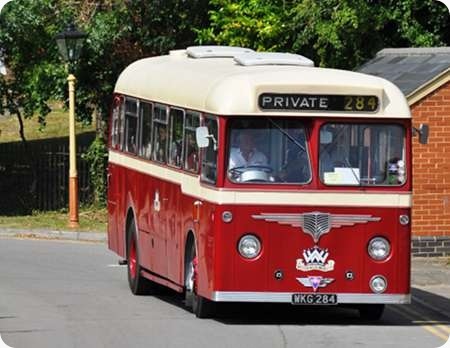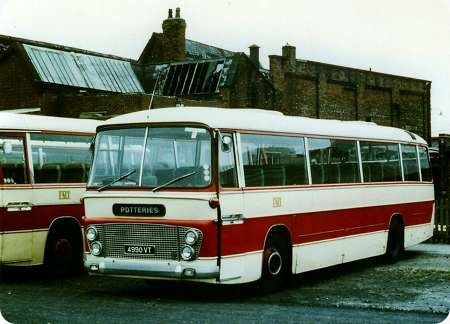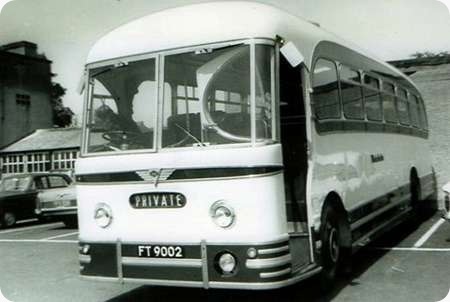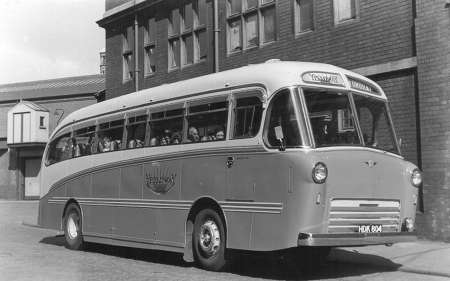Western Welsh – AEC Reliance – WKG 284 – 1284
Western Welsh Omnibus
1961
AEC Reliance 2MU3RA
Willowbrook DP41F
Delivered in 1961 to Western Welsh, WKG 284 is a dual purpose AEC Reliance with Willowbrook body. WKG 284 would last with the company until 1972 when it then passed to Gelligaer UDC. It has been restored by the RE-Liance Bus Preservation Group and was photographed from an open top vehicle arriving at the recent rally at the G & W Railway at Toddington.
Photograph and Copy contributed by Ken Jones
A full list of Reliance codes can be seen here.
15/09/13 – 09:39
Yet another beautiful restoration. With the PMT Leopard we also revisited the problems with the AEC wet-liner engines (470 and 590). What needs to be reiterated is that, especially with the 470, the engines pre-dated universal motorway usage and for all their foibles they were sufficient unto the day. AECs virtues always far outnumbered their vices.
David Oldfield
16/09/13 – 06:35
As David O says, another beautiful restoration, captured admirably by Ken. What has always puzzled me about this operator name was that I only ever saw services in south east Wales, not in the west. I see from that encyclopaedia site that there were operations in Tenby and parts of the West Country in the early days. I suppose they were hived off in the interests of "rationalisation".
Pete Davies
16/09/13 – 09:15
The "Western" in the company’s name refers to the Great Western Railway who were a major shareholder and contributed their existing services to the Combined operation. The same logic applied to the naming of Southern National (part owned by the Southern Railway), Southern Vectis (ditto), and Western National, plus of course Eastern National where LNER were a major owner.
Neville Mercer
16/09/13 – 13:10
In 1929, Great Western Railway bus services in South Wales were merged with those of a company called South Wales Commercial Motors. A new company, Western Welsh Omnibus Co. Ltd, was formed with a GWR share-holding.
This was during the period of large-scale acquisition of bus interests by the railways.
Geoff Kerr
17/09/13 – 05:10
Thank you, Neville & Geoff!
Pete Davies
17/09/13 – 05:12
The AEC 470 engine vehicles didn’t need a motorway to show up problems, David! On service work, minor cylinder head gasket failures, not enough to affect performance, would instantly cause an air lock in the heating system with the inevitable bookings of ‘cold heaters and demisters’. Oh that the cause could be rectified as quickly as the report could be written. The horizontal 470 was the bane of many an operations engineer’s life – wonder if the vertical version was any better? I never came across one to find out.
Ian Wild
17/09/13 – 05:14
Does anybody know (or care to suggest a reason) why, when Western Welsh elected to display route numbers, they chose yellow-on-black rather than white-on-black? . . . whilst retaining white-on-black for destination blinds?
Philip Rushworth
17/09/13 – 08:55
Philip, it’s an interesting question, especially as most indicator displays are now of the dot matrix or led system, and yellow on black. Why, indeed, would Western Welsh have gone the way they did?
When, roughly, did they go to this formation?
For the latter half of my working life, I was dealing with bus operations in particular but other elements as well, of traffic management in Southampton. Some of that work was dealing with disabled parking bays. One of my colleagues, the signs specialist, observed one day about the need to place a white or silver stripe round some (strangely, not all) sign posts, for the benefit of folk with defective eyesight. According to the manual, for instance, a bus stop pole ‘shall’ be either black or silver. How many of other colours do you see? Quite a lot, especially if operators provide and maintain their own. Some still do!
It provided a contrast. This is why many steps have an edge of different colour. One "Circular" he received mentioned the fact that, in conjunction with RNIB, it had been found yellow was an even better contrast, especially at night. A lot of people say they are waiting for "the number 62". They don’t want any others in the range of bus services that might serve a particular part of their town. They want the "62". Could Western Welsh have been among the first operators to realise that the yellow gives a better contrast when prospective customers are looking for a certain number?
Could they, perhaps but unlikely, have been the guinea pig operator for testing blinds? No, surely not, as this firm and Red & White had by then been merged into National Welsh.
Pete Davies
17/09/13 – 16:48
The smaller AH410 revealed the same problems as its larger capacity cousin. The Aldershot and District Reliances repeatedly incurred air locks in the cooling and saloon heating system, due, in no small measure, to the failure of the seals in the wet liners. Driving one of these buses on the very busy Cove services during a wet winter night with ineffective, cold demisters was, almost literally, touch and go insofar as forward vision was concerned. That a firm the size of AEC should prove incapable of producing reliable wet liner engines suggests a significant malaise in the design department. The much smaller Dennis company managed to make trouble free wet liner engines in petrol and diesel forms from the 1930s onwards to the end of its engine production programme. The first AEC wet liner engine was the "bootlace" or A172 motor of 6.754 litres which appeared in 1935, and this design, which had had a reputation for wet liner and gasket failures throughout its life, was the basis for the postwar AEC family of wet liner engines. It now seems incredible that, in decades of development, AEC could never cure the faults.
Roger Cox
18/09/13 – 05:41
One of our Depot Engineers with quite a number of Reliance 470s on his allocation became so desperate that he acquired two of those windscreen heaters with two rubber suckers used on cars in pre-demister days. These were duly fitted one to each screen of an errant Reliance, wired in series (couldn’t get 24volt versions) in an attempt to warm the cold air being pumped out by the demister and thus provide some degree of windscreen clearing. Not a success!! (but 10/10 for innovation!) Let’s not forget that the Leyland 0.350 fitted to the Tiger Cub etc was not too successful in the head gasket department either, made worse by the use of a single cylinder head.
Classy livery and practical too. NBC had a lot to answer for!
Ian Wild
25/09/13 – 07:27
Western Welsh used yellow route numbers to denote one-man operated services.
Nigel Utting
26/09/13 – 06:40
Thanks Nigel! But I’m now going to leaf through "Glory Days: Western Welsh" and "Shades of Red, White and Grey" to see if I can find any Renowns or crew-operated Atlanteans with yellow number blinds . . . which would put paid to your idea! (Although I hope it doesn’t.)
Philip Rushworth
27/09/13 – 06:55
You probably will, Philip – although that was the original intention, in time it rolled out across the fleet. Seemed a strange way of doing things, but there we are.
Nigel Utting
03/10/15 – 03:58
Western Welsh introduced 3 digit Route numbers in 1959. The first digit identified the depot the route was primarily operated by e.g., 2XX worked by Bridgend 8xx Haverfordwest.
The 24 Leyland Tiger Cubs with Park Royal B43F bodies SBO 240 to 263 Fleet Numbers 1240 to 1263 were the first fitted with destination indicators containing number roller blinds. Western Welsh used yellow route numbers from the outset. Services worked by OMO carried a black triangular flap with yellow lettering on the nearside front which could be inverted when working conventionally with a conductor.
Western Welsh’s operating territory covered the whole of South Wales and Monmouthshire with the notable exception of Swansea (South Wales transport). At its formation in 1929 the Great Western Railway services were based in Cardiganshire, Carmarthenshire, North Pembrokeshire, Neath, Abergavenny and Brecon. Those of South Wales Commercial Motors were based in Cardiff and Bridgend. Expansion into the Eastern and Western Valleys of Monmouthshire was achieved in 1933 and South Pembrokeshire as late as 1956 with the acquisition of Green’s of Haverfordwest. The only service into England was the Brecon to Hereford 730 service introduced in 1962 following closure of the Rail service and was an extension of the Brecon Hay on Wye service hitherto.
Stuart Davies
14/12/15 – 06:27
I worked as a turner at Ely garage in the seventies, and since then have wondered what the strange type of red the buses were painted was called. Anybody know? Also most of the buses had a diamond painted on their rear showing which depot they "belonged" to. Yellow was Ely, blue either Barry or Bridgend, Cross Keys black.
Ed
28/06/16 – 06:27
The colour the buses were painted in the 1970’s was National Bus Company ‘Poppy Red’.
This was one of the two standardised NBC liveries (but there were exceptions) introduced from late 1972 under Chairman, Freddy (later Sir Frederick) Wood.
Although these two NBC colours were actually British Standard colours and should have been the same on all vehicles, in practice, due to differing paint suppliers used by different companies there was actually some discernible difference between fleets.
Rob F
13/11/16 – 07:05
The BS Code for Poppy Red is 04 E 53
Paul Lloyd
03/11/17 – 07:35
A belated thanks to Paul Lloyd and Rob F. for their answer to my ‘What colour question’. Poppy red it is and shall be so evermore.
Ed
04/11/17 – 06:46
Well, Ed, not for evermore, because the Poppy Red usually faded into a strange and slightly odd pinky colour with the effluxion of time!
Chris Hebbron
04/11/17 – 06:47
Until it began to fade, as it very quickly did, and degenerated into "poppy orange".
Roger Cox
05/11/17 – 07:19
Regarding the yellow route numbers, the suggestion that they were specifically intended to identify one-man-operated services seems unlikely. You have to remember that, at that time, OMO (or OPO) was being introduced gradually – very gradually, in the case of some Western Welsh depots – so that it was very unlikely that any bus would have been used solely on OMO work.
Even into the mid-1970s, the unions at some depots refused to allow OMO with any vehicle with more than 45 seats; at other depots, such as Cardiff, the larger single deckers could be OMO, but there were several crew workings which also used these vehicles, particular at less busy times. Most of the early Atlanteans were rarely, if ever, used for OMO.
I suspect that the better contrast of yellow against a black background would have been the reason for using yellow numerals – although it would have been more logical to use it for all of the content of the destination blinds. However, it may have been more complicated to produce – as I understand it, the traditional blinds were white linen, with black paint. Thus, at night, the lights shone through the blind – but using yellow linen might have been more complex, or more expensive. Probably the latter!
Nigel Frampton
20/11/17 – 06:46
Yes Roger Cox and Chris Hebron, you are correct, I Forgot the Post Office van syndrome. I live in North Rd. Cardiff, and very occasionally I see a Western Welsh double decker heading Northward. Usually in the evening. Laugh you may, but to see this machine trundling out of the mist, a machine which was an integral part of my young days, and, I thought, gone forever, can be a little bit scary. Is this bus known to any of you bus people? I’d like to have a close look at it. See where we ‘fitters’ used to sit in the top deck, eating our sandwiches.
Ed
22/11/17 – 07:22
Nigel Frampton and others earlier on, mentioned coloured blinds versus white lettering on a black background. Just after the war, London Transport’s Green Line services had traditional white on black blinds, with GREEN LINE added. Before long, the blinds changed to black lettering on a yellow background (minus GREEN LINE) and remained so thereafter. Of course, these services also had unique buses/livery/route number ranges/bus stop style, all of which would have helped potential passengers to use them.
Chris Hebbron
Quick links to the - Comments Page - Contact Page - Home Page




